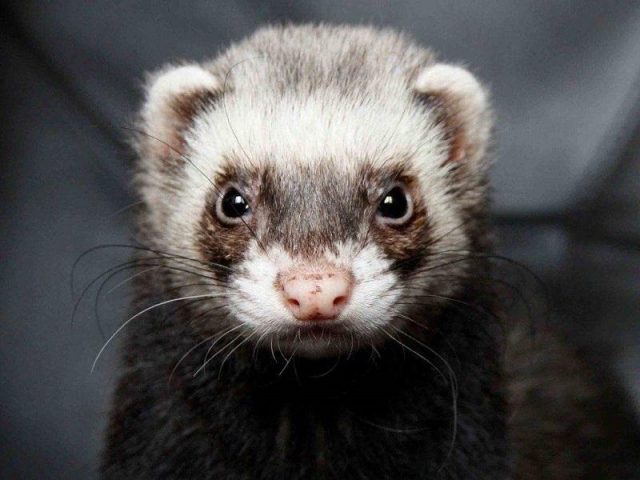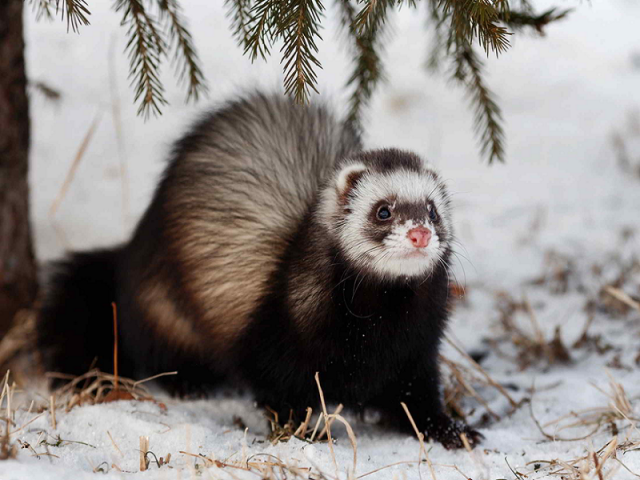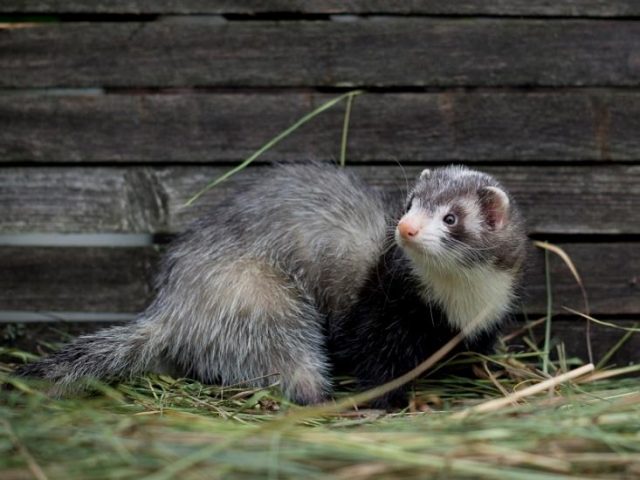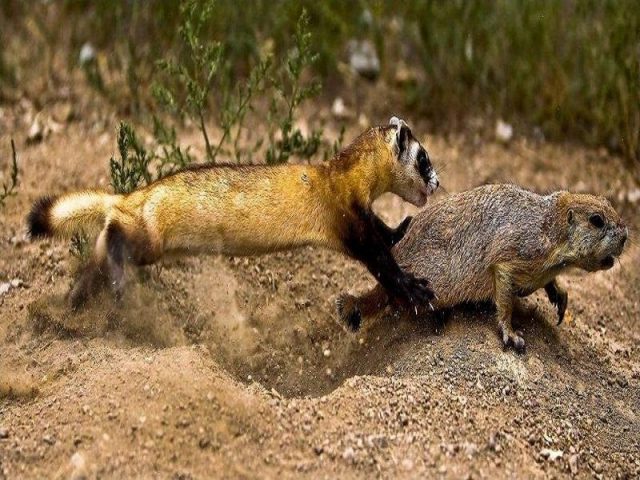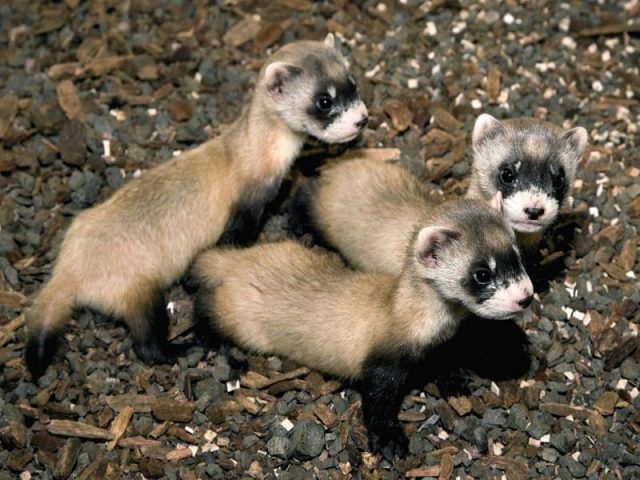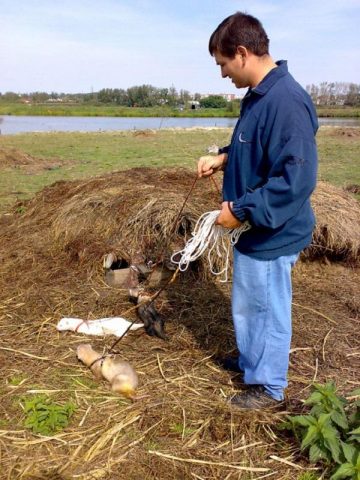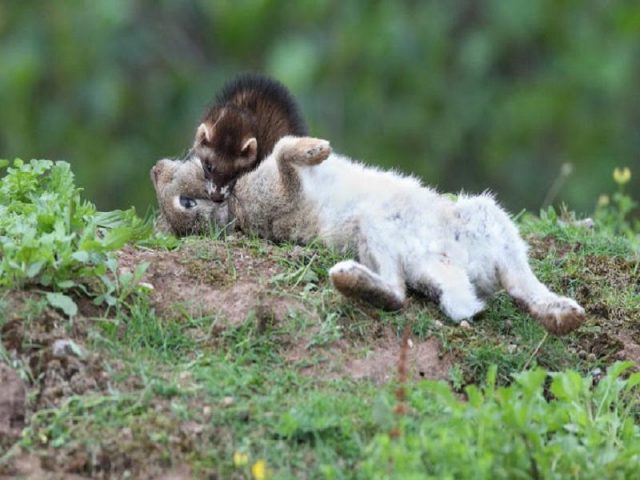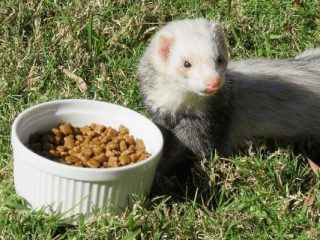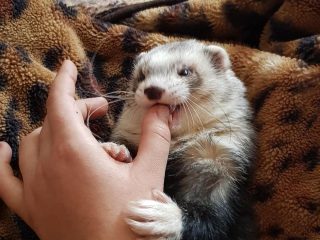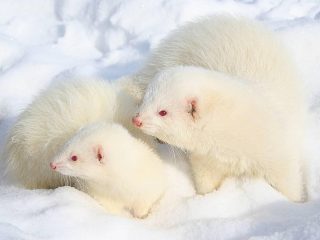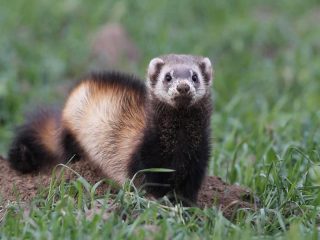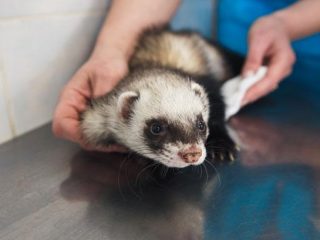Content
The polecat is a carnivorous mammal. He is bred as a pet. The animal gets used to the person, shows activity, friendliness, playfulness. But it is worth remembering that the wild ferret is a predator that behaves appropriately in times of danger: it uses teeth, the liquid of the anal glands with a strong odor.
Knowledge of habits, dietary habits, habitat, helps to better understand the behavior and nature of the predator.
What does a wild ferret look like
The forest, black or common ferret belongs to the weasel family, a carnivorous order of the mammalian class.
The appearance of the animal does not differ from its relatives in the family, but there are individual features:
- Color... The main color is brown-black. Paws, back, tail, muzzle are dark. There are white markings on the ears, chin, and forehead. Belly hair, lighter sides. In winter, the color of the animal is brighter and darker than the summer. Black ferret color options are red and albino.
- Wool... The fur of the animal is shiny, long (6 cm), not thick. Summer - dull, rare, winter - fluffy, black.
- Head... It is oval in shape, flattened at the sides, blending smoothly into a flexible long neck.
- Ears... The base is wide, the height is medium, the ends are rounded.
- Eyes... Brown, small, shiny.
- Body... The body of a forest animal is flexible, elongated, 40 cm long, mobile, allowing it to penetrate into narrow cracks and holes.
- Paws... The limbs of a wild ferret are short, thick (6 cm), which do not interfere with rapid movement. Paws with five toes, sharp claws, small membranes. Strong limbs allow the animal to dig the ground.
- Tail... Fluffy, ¼ the length of a predator.
- The weight... The indicator changes depending on the season. The maximum weight of a forest ferret is in the fall. At this time, animals are gaining weight, storing fat for the winter. Males weigh 2 kg, females 1 kg.
On numerous photos of a wild ferret, you can see animals with different shades of fur, sizes. Characteristics, basic standards are the same for all predators.
Ferret habits
When describing the ferret, the isolation of the animal's life is noted. Communication with congeners occurs during mating.
The forest animal has its own habitat, hunting. The area of the territory reaches 2.5 hectares, in females it is less. Possessions overlap, spread to the territory of other males. The stranger learns that the area is occupied by the marks left by the forest ferret.
The animal equips the house in a secluded place, in a heap of branches, under an old stump. The predator pulls out a mink with a short hole, makes a nest for rest. If a ferret is frightened away by a man or forest animals, he is looking for something new for the house.
In the daytime, the predator sleeps, at night it goes hunting. In the absence of food, it is removed over long distances. In bad weather, he sits in a hole for days.
The forest animal, which did not have time to return home with the onset of dawn, hides until dusk in badgers, hares or holes previously dug by them.
The wild forest ferret is fearless and aggressive. Meeting with a large predator does not stop him. He boldly rushes into battle.
The predator is ruthless to its victims. Once in the chicken coop and eating one chicken, it will strangle the rest. Under natural conditions, the animal acts in a similar way.
Where does the ferret live in nature
The forest wild ferret settles housing in a clearing, forest edge or in sparse vegetation.The place is usually located near rivers, lakes, water bodies. The predator has a sedentary lifestyle. He becomes attached to a specific place, equips the mink with enviable care. In the "bedroom" the forest ferret carries leaves, grass, rolls a hollow ball 25 cm in diameter, where it sleeps. If it gets hot, the animal removes the nest from the hole, and with the onset of cold, the animal increases the litter.
In winter, when it is difficult to get food, the forest predator settles closer to a person: in cellars, attics, hay stacks, sheds. In such places, he hunts rats, rabbits, chickens.
Where does the ferret live in Russia
The polecat lives in Eurasia. The bulk of the population is located in the European part of the Russian Federation - from the Urals to the western borders of the country. The animal does not live in North Karelia, the Caucasus, the Volga region. The size of an animal's population depends on the availability of food for it. There is a large population of individuals living in the territory of the Smolensk region.
Population of black ferrets
In addition to the territory of Russia, the forest ferret lives in England. The British predator population is plentiful. The animal settled on the territory of Finland, in the north-west of Africa.
The predator was brought to New Zealand to fight rats and mice. Soon he took root in a new place, began to threaten the destruction of the indigenous representatives of the New Zealand fauna.
Taking photos and videos of a ferret in nature is difficult: the population is constantly decreasing. The predator has strong, beautiful fur, due to the extraction of which mass destruction has led to a critical decrease in the number of individuals. Today, the forest ferret is listed in the Red Book, hunting for it is prohibited.
What ferrets eat in the wild
In the wild, the ferret eats animal food, but plant food is of little interest to him.
The predator is agile; shrews, mice, moles and other rodents easily become its prey.
The animal loves to feast on frogs, newts, lizards. Prefers the meat of hedgehogs, easily copes with a prickly enemy. He does not disdain snakes, even poisonous ones.
The ferret ruins nests, eats eggs, destroys birds.
The animal is able to catch a muskrat or a hare. The ability to sneak up silently helps the predator to hunt upland game. Keeps animals and insects out.
In the village it penetrates into chicken coops, goslings, where it eats and strangles poultry. The beast is able to make reserves for the winter, putting the prey in a secluded place.
A photo of a wild ferret that eats fish can only be taken at home: in natural conditions, it is difficult for an animal to catch it.
The predator's gastrointestinal tract is unable to digest fruits, berries, grass, and he rarely uses vegetation. He makes up for the lack of fiber by eating the contents of the stomachs of killed herbivores.
There is no shortage of food in the warm season. Since September, the forest ferret has been storing fats intensively. In winter, food is more difficult for him, he has to break the snow, catch mice, attack the hazel grouses and black grouses that have spent the night in the snowdrifts.
When there is no food, the animal does not disdain carrion and waste thrown away by a person.
Competition between individuals is not developed, since strong males hunt large prey, and weaker predators hunt small prey.
Breeding features
Wild ferrets become sexually mature by the age of one year. Until spring, he lives apart, a hermit. In April-May, in the second half of June, the rut begins. Forest predators do not perform special mating rituals. Males, when mating, behave aggressively. The female has teeth marks on her neck and a frayed withers. Bearing lasts 40 days, after which 4 to 12 pups are born, weighing 10 g. Ferrets are born blind and helpless. They grow and develop rapidly. They mature by a month, the mother feeds them with milk for seven weeks, then gradually transfers them to meat. Three months later, the whole brood, together with the mother, go hunting, helping her and learning all the wisdom.At this moment, the females desperately protect the brood from danger. Young people stay in the family until the fall. It is easy to distinguish the young from the parent by the juvenile "mane", long hair on the back of the neck.
In autumn, juveniles grow to adult sizes, reaching a weight of 2.5 kg. By winter, the animals grow up to half a meter in length. From this time on, an independent life begins for predators.
Enemies of wild ferrets
In the habitat of the forest ferret, there are large, strong predators that can harm it or eat it.
In the open area, the animal has nowhere to hide from the wolf, which can easily catch up. Foxes more often attack a wild ferret in winter, in times of famine, when mice cannot be found, and hares are difficult to catch.
Birds of prey - owls, owls, are ready to seize him at night. During the day, falcons and golden eagles hunt animals.
Do not leave any chance for the polecat for the life of the lynx. When a forest predator moves closer to human habitation, dogs pose a threat.
The civilization causes harm to the population. Developing territories, cutting down forests, laying roads, people force the animal to leave its usual environment. Uncontrolled hunting leads to a decrease in the population of small animals that are food for ferrets, and then the animal leaves its place of residence. Many animals fall under the wheels of transport. The number of predators is also decreasing due to the hunt for valuable skin.
The average life span of animals in nature is 5 years. A domesticated forest ferret, with proper care, can live for 12 years.
Despite the swiftness of the animal, a person who decides to make a video of a wild ferret can catch up with him. In this case, one must remember about the behavior of even a pet in a moment of danger. It is easy to get a fetid stream in the face from a predator's anal glands.
Interesting facts about forest ferrets
Today the ferret has become a domestic animal: along with cats and dogs, it lives near people. Many interesting facts are associated with it:
- the animals were domesticated 2000 years ago, they were used to hunt rabbits;
- in translation from Latin the word ferret means "thief";
- the animal's heart rate is 240 beats per minute;
- sensitive sense of smell and keen hearing compensate for the poor vision of the predator;
- the forest ferret sleeps up to 20 hours a day, it is difficult to wake him up;
- animals run equally skillfully in the usual way and backwards;
- domestic and wild ferrets do not live in peace and harmony;
- in an hour, a forest animal is able to dig a hole 5 meters deep;
- it can penetrate into any gap thanks to the flexible spine;
- at home, predators can sleep in a small box;
- when attacking, a wild ferret performs a combat dance - it jumps, inflates its tail, bends its back, hisses;
- a newborn baby fits in a teaspoon;
- the percentage of albinos is large, animals have red eyes;
- ferrets can swim, but they don't like to do it;
- in New York and California, it is forbidden to keep them at home: escaped individuals can damage the environment by forming colonies;
- In 2000, domestic ferrets attacked a ten-day-old girl in Wisconsin and was rescued by a dog. It is believed that babies smell like milk, predators see them as an object of prey;
- the neck muscles of animals are so strongly developed that a small forest animal is able to drag a rabbit;
- the flexibility of the body of a wild ferret, the ability to penetrate any gap was used in the construction of Boeings and the Hadron Collider, animals pulled wires in hard-to-reach places;
- Leonardo da Vinci's "Lady with an Ermine" actually depicts an albino ferret.
Conclusion
The ferret has long ceased to be only a wild animal. He lives next to a person, with proper care, he brings offspring. When socializing at an early age, he loves contacts with people, to whom he later gets used to.
The forest ferret is a striking representative of the wild nature, which is its decoration. It is necessary to preserve the animal population so that the species does not disappear from the face of the earth without the possibility of restoration.
If the animal is wild, it is difficult to take a photo of the ferret, but this is not the most important thing. Enough filming at home. Wild animals must remain that way.
